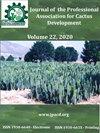在饲料仙人掌无性系的形态特征和产量之间的关系根据水制度的变化:一个主成分分析
IF 0.4
4区 农林科学
Q4 HORTICULTURE
Journal of the Professional Association for Cactus Development
Pub Date : 2022-06-11
DOI:10.56890/jpacd.v24i.475
引用次数: 0
摘要
牧草仙人掌具有明显的形态特征,与产量有关,并受不同水分条件的影响。采用主成分分析法(PCA)分析了不同水分条件下饲草仙人掌无性系的形态和生产力变量之间的关系。我们在巴西半干旱地区Serra Talhada种植了Miúda(MIU)、Orelha de Elefante Mexicana(OEM)和IPA Sertânia(IPA)无性系,其水分状况基于作物蒸发蒸腾量(0%、40%、80%和120%ETc)。2016年至2018年间,获得了形态和作物生产力数据。两个主要成分解释了数据总变异性的>82%,形态和生产变量之间的关系取决于克隆和水情。新鲜和干物质的生产更多地受到MIU和OEM克隆的形态特征的影响。IPA克隆在所分析的变量之间没有显示出相关性,而与水分状况无关。PCA可用于了解植物的生长动态,并确定仙人掌无性系生产中的水分条件,有利于在培养中进行更好的管理。本文章由计算机程序翻译,如有差异,请以英文原文为准。
The association between morphological characteristics and yield in forage cactus clones varies according to water regimes: a principal component analysis
Forage cactus species exhibit distinct morphological characteristics, which have a relationship to yield and can be affected by different water conditions. The objective was to analyze, with the principal components analysis (PCA), the association between morphological and productivity variables in forage cactus clones in different water regimes. We cultivated, in Serra Talhada, Brazilian semiarid, the Miúda (MIU), Orelha de Elefante Mexicana (OEM) and IPA Sertânia (IPA) clones under four water regimes based on crop evapotranspiration – ETc (0%, 40%, 80% and 120% ETc). Between the years 2016 and 2018, morphological and crop productivity data were obtained. Two main components explained >82% of the total variability of the data, and the relationship between morphological and production variables depended on the clone and the water regime. The production of fresh and dry matter was more influenced by the morphological characteristics in the MIU and OEM clones. The IPA clone showed no correlation between the variables analyzed, regardless of the water regime. PCA can be used to understand the growth dynamics of plants and to identify the water conditions that act in the production of cactus clones, favoring better management in the cultivation of culture.
求助全文
通过发布文献求助,成功后即可免费获取论文全文。
去求助
来源期刊

Journal of the Professional Association for Cactus Development
Agricultural and Biological Sciences-Plant Science
CiteScore
1.10
自引率
33.30%
发文量
10
期刊介绍:
The editors of the Journal of the Professional Association for Cactus Development, are very excited to be a part of the excellent editorial committee and to work together to create the synergism between scientists, growers, legislators, and business people so vital to the development of this industry to serve the people of arid lands.
 求助内容:
求助内容: 应助结果提醒方式:
应助结果提醒方式:


